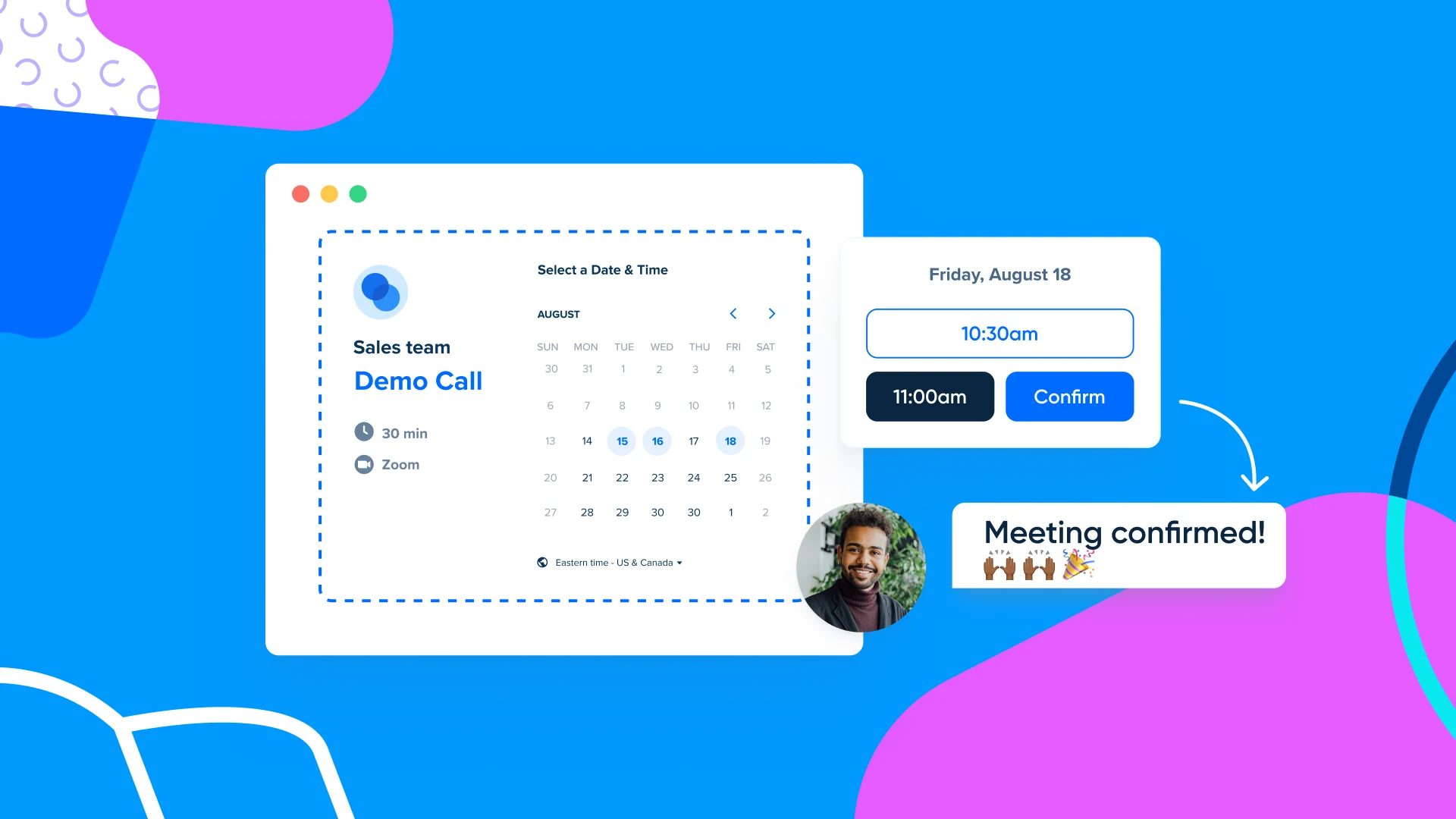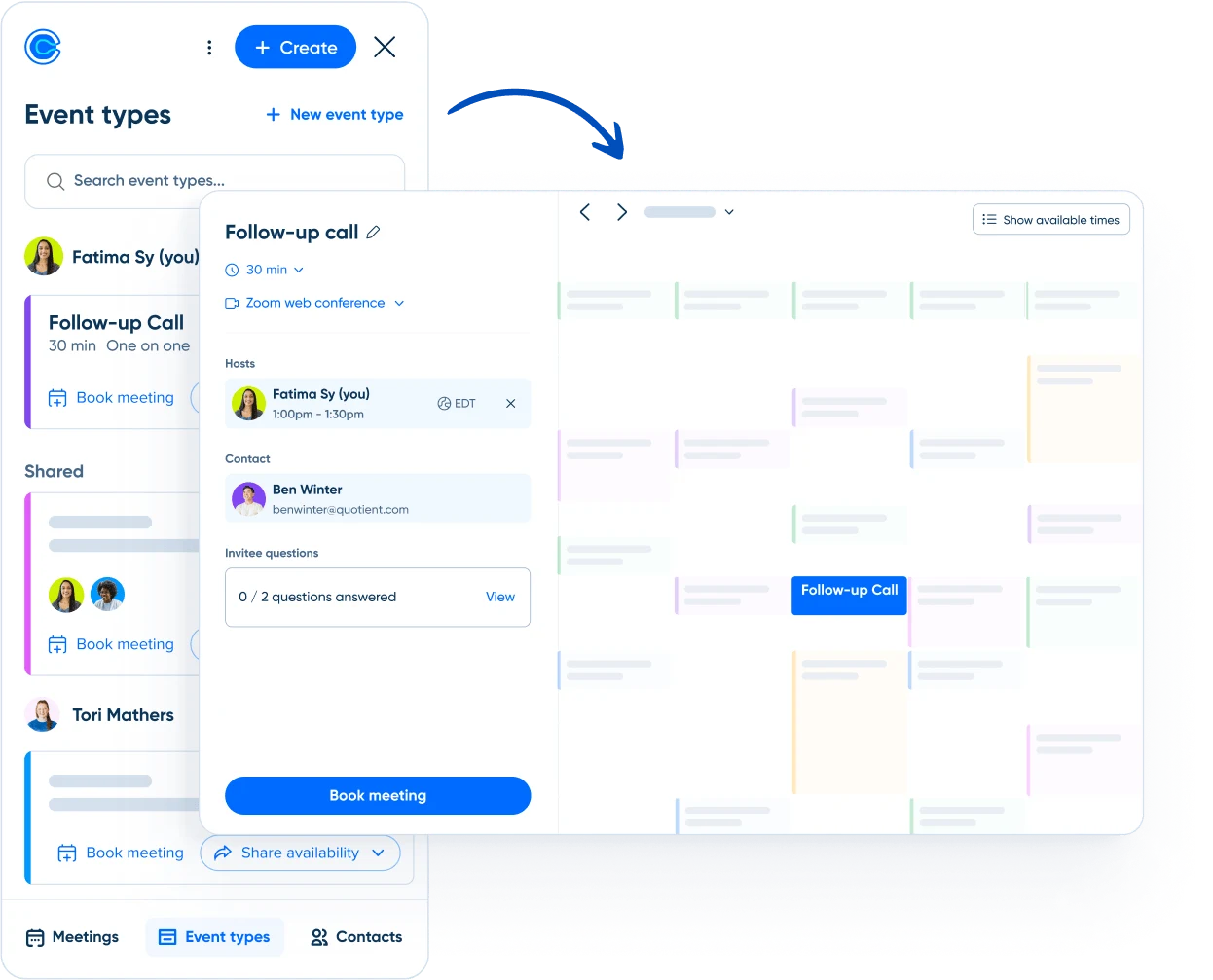Pro tips
How to host better sales demos: 11 tips from sales pros
Run demos that close deals with these tips from B2B sales pros.
Rachel Burns
Jun 18, 2024
12 min read
Table of contents
A lead discovers your product and fills out a demo request form on your website. Based on their form responses and an initial discovery call, they’re a great fit for your solution.
… Now what?
Your sales demo can mean the difference between closing a major deal and losing out to the competition. Great product demos are more than just eloquent sales presentations. The demo process starts long before you get on the call, and continues after you hang up.
To help you host better demos, we've gathered some tried-and-tested advice from B2B sales pros. Learn how they prep presentations, tailor demos to prospects’ needs, tackle objections, keep the sale cycle moving, and close deals.
1. Make demos easy to schedule
Before you can host a successful sales demo, you have to schedule it.
Few things kill deal momentum like endless back-and-forth scheduling emails. For 69% of the revenue teams surveyed during Calendly’s Growth Week, getting leads to actually schedule a meeting is the hardest part of inbound sales.
Some sales teams require a discovery call before a demo. Others let prospects book demos as the first sales call. Here are three ways to make demo scheduling easy, no matter where prospects fall in your sales process:
1. Include demo booking links in your nurture emails
An influx of leads made it hard for the sales team at Signpost to keep up, and leads started falling through the cracks. Julia Pan, Sales Enablement Manager, began adding reps’ Calendly booking links to the nurture campaigns that leads receive after requesting a Signpost demo. Now, with just one click, leads can see the sales rep’s availability and book a time that works for everyone.
“A good tool is one that’s so simple, sales reps can basically forget about it and let the meetings roll in. That’s what happened when we implemented Calendly.”
Julia Pan
Sales Enablement Manager at SignPost
2. Use collective scheduling to find time that works for AEs and SEs
When multiple team members co-host demos, it can add an extra level of scheduling complexity.
At Calendly, AEs and SEs co-host demos. Calendly’s Collective events pool the availability of both hosts on one booking page.
Enterprise AEs share the collective scheduling link in their email convo with prospects, and invitees can only select meeting times that are open on both the AE and SE’s calendars.
“Calendly has also been a game changer for coordinating meetings with my AEs. Before having a tool like this, I would be booked over, not given notice, or booked after hours. It’s made for a much better experience for us and the customers!”
Dave Evatt
Senior Solutions Engineer at Calendly
3. Add demo booking to your website forms
The old way: A prospective customer fills out your “request a demo” form, then waits to hear back from you to schedule a demo.
The new way: A lead fills out your “request a demo” form, matches your lead qualification criteria, and is instantly taken to a booking page to choose a demo time that works for them.
When you add lead qualification and booking to your website forms through a tool like Calendly Routing, you can:
Turn visitors into booked demos at the height of their interest
Spend less time manually following up with inbound leads
Feel confident you’re focusing on high-value deals
“Our HubSpot form conversion rates have skyrocketed with Calendly Routing. We’re now seeing 70% of qualified leads booking demos directly from our website. Our entire team is thrilled.”
Max Friedman
CEO at Givebutter
2. Ask the right questions
Some sales teams have an intro discovery call before leads can be shown a demo, while other sales processes use form fills and research to gather info. Either way, discovery is crucial for tailoring sales demonstrations to prospects’ specific needs. “Your doctor won’t give you a prescription without first understanding what is making you sick. Same applies for demos,” says Dave Evatt, Senior Sales Engineer at Calendly.
“The key to a successful demo is to first understand the outcome that the client is trying to achieve — their goals, pain points, metrics of success.”
Sally Baldauf
Global VP of Presales at Gong
Your discovery process should answer questions like:
What are the biggest challenges facing your business right now?
What goals are you hoping to achieve with [your type of product]?
What’s your budget for this project?
Have you used similar products in the past? What were the results?
Who are the key decision-makers involved in this purchase?
What’s your timeline for making a decision and implementing a solution?
Are there any specific features that are must-haves for your business?
Are you currently evaluating other options? If so, what factors are influencing your decision?
Gather this info via discovery calls, marketing forms, booking page questions, data enrichment tools like Clearbit, or all of the above. Then, save that info in your CRM, so you can refer to it as you plan your demo roadmap.
To make sure nothing gets lost in translation between the discovery call and demo, Calendly’s solutions engineers swear by Gong’s call recording and analysis software.
“Gong has become critical to my success as an SE. As much as I would love to be on every discovery call, I’m not. Having the full recording that I can interpret myself, as opposed to relying on the manual notes of the AE, allows me to have a more tailored demo for prospects.”
Ben Wright
Principal Sales Engineer at Calendly
3. Avoid no-shows with automatic reminders
Sales pro horror story: You prep the most well-researched, customized demo, and … your prospect’s a no-show. They don’t reschedule or cancel. They just ghost you.
Of the revenue team members we surveyed during Growth Week, 36% said that no-show prospects are a top challenge to moving deals forward. But you don’t have time to send manual reminder emails for every single meeting on your schedule.
Enter: Automated email and text reminders.
The sales team at CallRail uses Calendly Workflows to automate meeting reminder emails. These reminders serve double duty, keeping upcoming meetings top-of-mind, and asking prospects to share any last-minute questions. The results? More tailored demos, doubled meeting conversion rates, and reduced no-shows.
“We used automated reminders as an opportunity to ask our free trial users what questions they had about our product. Not only are these reminders helpful, but they also make our meetings more to-the-point and shape the discussion for our sales team members and customers.”
Nick Jackson
Sales Manager at CallRail
If something comes up, and a prospect’s no longer available, it doesn’t have to be “goodbye forever.” Include a rescheduling link in your reminder messaging to keep the deal moving forward.
4. Choose sales tools that work well together
Automation and integrations go hand-in-hand when it comes to saving time and getting more done. When all of your tools talk to each other, all of the data you need is in one place, making the handoff from marketing to AE to sales engineer smoother.
Integrating Salesforce, Gong, and Calendly is a winning combo for many sales pros — including our team. Here’s how it works:
When you add Gong to discovery and demo calls booked via Calendly, Gong automatically joins scheduled calls as a virtual meeting participant, then records and analyzes your sales calls.
When a lead books a meeting via Calendly, Salesforce checks to see whether the lead already exists in your Salesforce instance. If so, Salesforce CRM automatically adds the meeting details and prospect info to their record. If not, Salesforce automatically creates a new lead, contact, or opportunity.
Salesforce serves as your source of truth for all prospect info, automatically updating records with insights from Gong and meeting details from Calendly. This gives SEs access to the up-to-date info they need to prepare for demos more effectively.
Reps spend less time on manual data entry, jumping between platforms, and chasing down meeting notes — and more time closing deals.
“Integrations make everyone's life easier because trustworthy data is in one place. Seeing data from multiple places all in a Salesforce record helps with visibility and transparency.”
Riley Humes
Revenue Operations Manager at Calendly
Speaking of apps, do a quick test run of all of your tech — screen sharing, audio, video, Wi-Fi, etc. — before each demo. You’ll feel more confident going into the presentation when you’re certain everyone can see and hear you.
5. Use an agenda to set expectations and structure the demo
“Running a successful sales meeting involves clear communication before, during, and after.”
Morgan J. Ingram
Chief Executive Officer at Ascension Media Productions (AMP)
Setting expectations throughout the demo process keeps things clear and organized, shows you respect your prospect's time, and demonstrates you're professional and prepared.
“Often, attendees aren't sure what to expect, so we have to make sure to set the tone before the call even happens,” says Morgan J. Ingram, Founder and CEO at Ascension Media Productions (AMP).
Here’s Morgan’s framework for setting up successful sales calls:
Before the demo: Use your discovery research to create an agenda and share it with your prospects 24 hours before the call. Your agenda should include:
Topics you’ll cover
Any questions you’d like them to think about beforehand
Relevant use cases
Time for Q&A and next steps
During the demo: At the start of the call, refer back to the agenda you shared. Also, ask if they have any last-minute agenda items or a hard stop, so you can keep things on track and adjust your plan accordingly.
After the discovery call: The AE playbook for driving deals from demo to close
6. Make it a conversation, not a show-and-tell
“There’s an art to this. A demo is less of a show-and-tell, and more of a conversational, problem-solving exercise.”
Dave Evatt
Senior Solutions Engineer at Calendly
Agendas are a scaffold of key points to build the call around, not a word-for-word script.
If the conversation takes a turn that wasn’t on the agenda, but lets you answer an important question or demonstrate a valuable part of your product, go with it! If you can tell attendees are losing interest, adjust your pace or move on to the next point.
“Let them talk, try not to talk at them for long periods of time, and make the demo your own personal flavor. It doesn't need to feel like a script!”
Patrick Moore
Senior Solutions Engineer at Calendly
Make the demo interactive. Instead of just presenting features, ask questions, get feedback, and adapt your presentation based on their responses. “Know your audience, their titles and positions and how it's relevant to your demo, so you can call out individuals by name or ask them questions directly throughout,” says Ben Wright, Principal Sales Engineer at Calendly.
“The most important thing you can do on a sales demo is ask questions. They should be questions related to the problems you solve so that the trail leads back to what you're selling. However, the less you can talk about you, your company, or your product, the more excited a prospect will get about the opportunity to solve their problem in partnership with you.”
Leslie Venetz
Founder at The Sales-Led GTM Agency
7. Show how your product fits into (and improves!) their day-to-day
Many product demos are a rapid-fire laundry list of features. But chances are, not every customer is going to use every product feature in the same way. Narrow down your demo to the real-world use cases that make your product the right choice for that specific prospect.
For example, if you’re demoing a scheduling automation platform for a potential customer in the financial services industry. You’d focus on the functionality that creates a better experience for FinServ clients: a modern booking experience for new client acquisition, enterprise-grade security features, and automations that help advisors stay in touch with clients and make sure they show up to their appointments.
“Relate features of the product back to key points from the stakeholders during discovery,” says Dave. “For example, ‘Mary, you mentioned that XYZ is an issue today and it costs you ABC hours. Here’s how Calendly can solve for this …’”
“Understand the persona you’re speaking to and target the delivery of the demo to meet their desired goals, showing clear business value. Don’t be afraid to pivot the demo along the way as needed.”
Sally Baldauf
Global VP of Presales at Gong
8. Ditch the technical jargon
As you walk through these features, remember that you’re an expert in your product, but your prospects aren’t. In SaaS sales, product demonstrations can get technical, fast, and it’s easy to slip into autopilot. Your goal is to show how your product can help them, not to overwhelm them with technical details.
Slow down! Every time you click on something, explain what you’re doing and why. Taking your time also gives attendees time to ask questions in the moment. All of this means your prospect is more likely to understand how your product works and envision how they'll use it in their everyday work.
“Make sure you’re always communicating the ‘why’ of what you're showing. You never want to assume your audience is connecting the dots of their issues to your solution on their own.”
Dave Evatt
Senior Solutions Engineer at Calendly
9. Tackle objections with empathy and curiosity
Objections are a natural part of any sales demo. Here’s how Calendly’s team handles objections to build trust and keep the deal moving forward:
1. Make them feel heard: “Try an empathetic approach to clarify that you understand exactly what their objection is,” says Patrick Moore, Senior Sales Engineer at Calendly. “No arguing, no confrontation. Try to get them to expand as much as possible so you can get any helpful nuggets.”
2. Ask questions: “Asking questions to fully understand the severity of the objection is key,” says Dave. “Sometimes, a client is raising an objection that is irrelevant to their use case, or they may have misunderstood the solution you’re offering. It’s better to dig into this and get more context before reacting.”
“If the objection is to something your tool can’t accomplish, ask the prospect how important that objection is. Is it mission critical, or just a 'nice-to-have?' Acknowledge the objection, and then continue to find the value for the prospect in what you do have to offer.”
Ben Wright
Principal Sales Engineer at Calendly
3. Share relevant examples: Explain how other clients in similar situations have dealt with the same issue. This is a great opportunity to bring customer stories and case studies into the mix, especially if you have data to back up other clients’ successes.
4. Stay humble: Approach objections with humility and a genuine desire to understand. Dave says, “We never want to become combative with client objections, so asking questions and sympathizing can often help a client overcome an objection and, in turn, help you to build trust.”
10. Schedule next steps before the end of the call
Leslie Venetz, Founder at The Sales-Led GTM Agency, says top AEs swear by this technique to close deals faster: Book your next meeting before the end of your current call.
“It removes friction from the buying process. There’s no need for back-and-forth. You aren’t asking your prospect to put another to-do on their list. You’re making it easy to buy from you,” she says.
If the prospect says yes, you’re well on your way to pricing proposals and negotiations — and closing the deal. (If they say no, use it as an opportunity to learn more about what’s holding them back.)
The data agrees: Gong Labs found that successful reps spend 12.7% more time on demo calls discussing next steps.
“As the call wraps up, make sure to leave 7-9 minutes to guide prospects through the next steps,” says Morgan. “I book these meetings directly from Calendly's browser extension while still on the call. Calendar invites are sent before we end the call so you remove the possibility of being ghosted.”
“It’s a huge benefit to be able to book immediately versus having to chase a customer down. It increases the likelihood of meeting with them again and leaves more time to focus on their needs during the actual call.”
Gabriele Borges de Souza
International Onboarding Consultant at Docusign
11. Follow up with helpful resources
Whether you’ve booked next steps or not, following up after a demo keeps the momentum going.
Calendly SEs work with AEs to coordinate post-demo follow-ups. “Usually, this involves sharing a copy of the call recording, a series of help center articles relevant to topics we discussed on the demo, and an offer to schedule an additional follow-up call using our Calendly collective Event Type,” says Ben.
Follow-up emails are also a great opportunity to share testimonials and case studies from customers in the prospect’s industry. If you know you’re up against a competitor, send over a battlecard showing why your solution wins out. Give potential customers all of the info they need to make an informed, confident decision.
“Back up the information that you shared in the demo. Say they said in the demo they're struggling with no-shows. In my follow-up email, I'll send links to short videos and help center articles to demonstrate how features like reconfirmation buttons and reminder Workflows prevent no-shows.”
Melany Furlow
Enterprise Account Executive at Calendly
Better demos = more deals closed, faster
A successful sales demo is more than just a walkthrough of what your product can do.
With these sales demo tips, you can make each demo an informative, engaging, and collaborative experience that moves deals forward.
Get this right, and you're not just closing a deal — you're building a relationship.
Get started with Calendly
Ready to make scheduling easier than ever?
Rachel Burns
Rachel is a Content Marketing Manager at Calendly. When she’s not writing, you can find her rescuing dogs, baking something, or extolling the virtue of the Oxford comma.
Related Articles
Don't leave your prospects, customers, and candidates waiting
Calendly eliminates the scheduling back and forth and helps you hit goals faster. Get started in seconds.
Calendly eliminates the scheduling back and forth and helps you hit goals faster. Get started in seconds.















